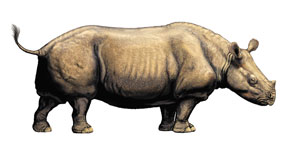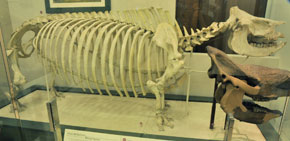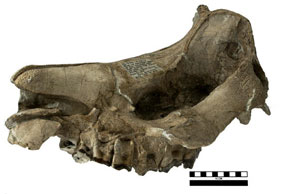Ashfall
Special Sites: Ashfall Fossil Beds
In 1971, University of Nebraska Paleontologist Mike Voorhies was prospecting for fossils in a ravine at the edge of a cornfield North of the town of Royal, Nebraska, when he found the perfectly preserved skull of a baby rhinoceros projecting from a layer of soft volcanic ash. As Voorhies began to excavate, he realized that the skull was connected to the rest of the animal’s skeleton and that there were other, equally well-preserved rhino skeletons around it.
Since then, over 200 skeletons of fossil vertebrates have been discovered at the Ashfall site. The majority of these are from the extinct rhino Teleoceras major. Unlike most fossil deposits, which consist of scattered bones accumulated over extended periods of time, the ash bed discovered by Voorhies contained mostly articulated remains with bones still joined together in the proper order and in near perfect three-dimensional preservation. Some of the skeletons even contain unborn young and stomach contents.
Chemical analysis of the surrounding ash revealed that it was produced by a volcano in Southwest Idaho that erupted around 12 million years ago. The volcano spread a blanket of harsh, abrasive ash, one or two feet deep across a very large area, including the flat savanna-like grasslands of what is now northeastern Nebraska. The animals that lived in this area mostly survived the actual ashfall, but as they continued to graze on the ash covered grasses, their lungs began to fill up with the glassy powder. Soon their lungs became severely damaged and they began to die. Their bodies were quickly covered by the blowing and drifting ash.
The preservation of a complete herd of extinct rhinos, in exceptional condition, has enabled paleontologists to study the ecology and behavior of Teleoceras at a level of detail that is extremely unusual for an ancient and long-extinct animal. And the Ashfall site doesn’t just include rhinos – there are five different species of horse and three species of camels present as well, plus birds and reptiles; over seventeen species of vertebrates in all. The ash bed also contains abundant additional clues to the vegetation and climate of the landscape in which the rhinos and other animals lived and died. In the words of its discoverer, the site is “truly a 'time capsule' presenting us with a picture of a vanished world unrivaled in detail and clarity.” In 1991, the Ashfall site became a Nebraska state park, the Ashfall Fossil Beds State Historical Park. Visitors to the park can see the rhino skeletons and other remains in situ, as they were discovered.



